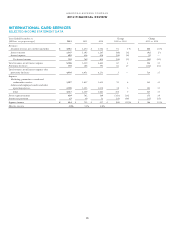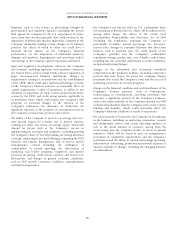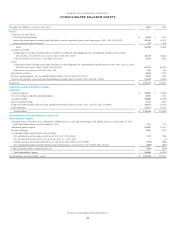American Express 2012 Annual Report Download - page 55
Download and view the complete annual report
Please find page 55 of the 2012 American Express annual report below. You can navigate through the pages in the report by either clicking on the pages listed below, or by using the keyword search tool below to find specific information within the annual report.AMERICAN EXPRESS COMPANY
2012 FINANCIAL REVIEW
interest expense on the Company’s long-term financing and
short-term borrowings, which primarily relates to interest
expense on commercial paper, federal funds purchased, bank
overdrafts and other short-term borrowings.
Interest income — Interest income includes (i) interest on
loans, (ii) interest and dividends on investment securities and
(iii) interest income on deposits with banks and others.
Interest on loans is assessed using the average daily balance
method for owned loans. Unless the loan is classified as non-
accrual, interest is recognized based upon the principal amount
outstanding in accordance with the terms of the applicable
account agreement until the outstanding balance is paid or
written off.
Interest and dividends on investment securities primarily
relates to the Company’s performing fixed-income securities.
Interest income is accrued as earned using the effective interest
method, which adjusts the yield for security premiums and
discounts, fees and other payments, so that the related
investment security recognizes a constant rate of return on the
outstanding balance throughout its term. These amounts are
recognized until these securities are in default or when it is likely
that future interest payments will not be made as scheduled.
Interest income on deposits with banks and other is recognized
as earned, and primarily relates to the placement of cash in
excess of near-term funding requirements in interest-bearing
time deposits, overnight sweep accounts, and other interest
bearing demand and call accounts.
Merchant acquisition — Represents the signing of merchants to
accept American Express-branded cards.
Net card fees — Represents the card membership fees earned
during the period. These fees are recognized as revenue over the
covered card membership period (typically one year), net of
provision for projected refunds for cancellation of card
membership.
Net interest yield on cardmember loans — Net interest yield on
cardmember loans is computed by dividing adjusted net interest
income by adjusted average loans, computed on an annualized
basis. The calculation of net interest yield on cardmember loans
includes interest that is deemed uncollectible. For all
presentations of net interest yield on cardmember loans, reserves
and net write-offs related to uncollectible interest are recorded
through provisions for losses — cardmember loans; therefore,
such reserves and net write-offs are not included in the net
interest yield calculation.
Net loss ratio — Represents the ratio of charge card write-offs
consisting of principal (resulting from authorized and
unauthorized transactions) and fee components, less recoveries,
on cardmember receivables expressed as a percentage of gross
amounts billed to cardmembers.
Net write-off rate — principal only — Represents the amount
of cardmember loans or USCS cardmember receivables written
off consisting of principal (resulting from authorized
transactions), less recoveries, as a percentage of the average loan
balance or USCS average receivables during the period.
Net write-off rate — principal, interest and fees —Includes,in
the calculation of the net write-off rate, amounts for interest and
fees in addition to principal for cardmember loans, and fees in
addition to principal for cardmember receivables.
Operating expenses — Represents salaries and employee
benefits, professional services, occupancy and equipment,
communications and other expenses.
Return on average equity — Calculated by dividing one-year
period net income by one-year average total shareholders’ equity.
Return on average segment capital — Calculated by dividing
one-year period segment income by one-year average segment
capital.
Return on average tangible segment capital —Computedinthe
samemannerasreturnonaveragesegmentcapitalexceptthe
computation of average tangible segment capital excludes from
average segment capital average goodwill and other intangibles.
Risk-weighted assets — Refer to the Capital Strategy section
under “Consolidated Capital Resources and Liquidity” for the
definitions under Basel I and Basel III.
Segment capital — Represents the capital allocated to a
segment based upon specific business operational needs, risk
measures, and regulatory capital requirements.
Stored value and prepaid products — Includes Travelers
Cheques and other prepaid products such as gift cheques and
cards as well as reloadable Travelers Cheque cards. These
products are sold as safe and convenient alternatives to currency
for purchasing goods and services.
Three-party network — A payment network, such as American
Express, that acts as both the card issuer and merchant acquirer.
Tier 1 common risk-based capital ratio — Refer to the Capital
Strategy section under “Consolidated Capital Resources and
Liquidity” for the definitions under Basel I and Basel III.
Tier 1 leverage ratio — Refer to the Capital Strategy section
under “Consolidated Capital Resources and Liquidity” for the
definitions under Basel I and Basel III.
Tier 1 risk-based capital ratio — Refer to the Capital Strategy
section under “Consolidated Capital Resources and Liquidity”
for the definitions under Basel I and Basel III.
Total cards-in-force — Represents the number of cards that are
issued and outstanding. Non-proprietary cards-in-force includes
all cards that are issued and outstanding under network
partnership agreements, except for retail co-brand cardmember
accounts which have no out-of-store spend activity during the
prior 12-month period.
Total risk-based capital ratio — Refer to the Capital Strategy
section under “Consolidated Capital Resources and Liquidity”
for the definition.
Travel sales — Represents the total dollar amount of travel
transaction volume for airline, hotel, car rental, and other travel
arrangements made for consumers and corporate clients. The
Company earns revenue on these transactions by charging a
transaction or management fee.
53
























